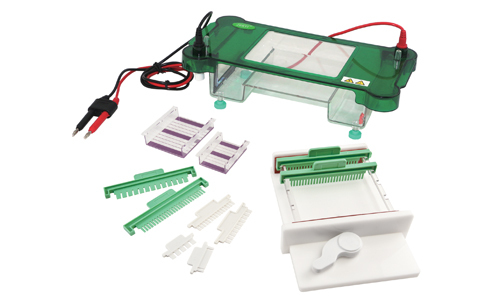Gel electrophoresis is a group of techniques used in order to separate molecules, based on their properties such as size, shape and isoelectric point, in this process the molecules are separated due to the difference in their charge. net. Consequently, gel electrophoresis is very effective in separating complex mixtures of proteins or other molecules.
The gel electrophoresis apparatus includes several components; each of these components has a key role for the process that occurs when DNA or protein fragments are run on the gel. Among which are:
Staining and visualization
The gels are typically stained with a chemical called ethidium bromide, which can be inserted between the two strands on a double-stranded DNA fragment. It floures brilliantly when DNA-bound, thus exposing the gel to ultraviolet light will make the bands of DNA fragments visible. Because UV light is harmful to human eyes, the gel is generally examined in an ultraviolet light box called a transilluminator. The UV illuminated gel is typically photographed so the results can be analyzed later.
Gel
The gel is used for electrophoresis of DNA fragments; it is made of agarose, a starch polymer. Preparing the gel is simply a matter of mixing agarose powder with a chemical stopper and heating it in the microwave; the gel can be poured and allowed to cool. Proteins are usually separated on a polyacrylamide gel. This gel is prepared from an acrylamide monomer, with the addition of ammonium persulfate and tetramethylenedimine to the acrylamide, mixing causes the acrylamide to polymerize and harden.
Tank
The tank is made of plastic; It contains a gel bed in which the gel is placed. On either side are two plastic baffles that hold the gel in place while it is cooling. Once the gel has solidified, the tank is filled with buffer so that the buffer level is just above the gel; The lid of the electrophoresis chamber contains the electrodes that supply the current source of the power source, which maintains a certain voltage. Once it is turned on the negatively charged DNA fragments will begin to migrate towards the positive electrode (anode). Protein electrophoresis is similar but the gel is directed vertically.
Comb and micropipette
When pouring the gel, a plastic comb is used to create small square depressions called wells- in it. DNA samples will later be loaded into these wells using a micropipette. Like larger pipettes, a pipette is designed to take and dispense precisely calibrated liquid. Micropipettes are generally adjustable so that the user can determine how many microliters to add. The solution is in the tip of the plastic pipette, which is generally used only once before being discarded to avoid contamination.
Gel electrophoresis is used in multiple fields of science, such as genetics, molecular biology and biochemistry, as well as forensic medicine.
At Kalstein we are MANUFACTURERS and we offer quality products at the best PRICE on the market. Visit us on our website, in the products section. HERE


